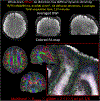Distortion-free, high-isotropic-resolution diffusion MRI with gSlider BUDA-EPI and multicoil dynamic B0 shimming
- PMID: 33748985
- PMCID: PMC8121182
- DOI: 10.1002/mrm.28748
Distortion-free, high-isotropic-resolution diffusion MRI with gSlider BUDA-EPI and multicoil dynamic B0 shimming
Abstract
Purpose: We combine SNR-efficient acquisition and model-based reconstruction strategies with newly available hardware instrumentation to achieve distortion-free in vivo diffusion MRI of the brain at submillimeter-isotropic resolution with high fidelity and sensitivity on a clinical 3T scanner.
Methods: We propose blip-up/down acquisition (BUDA) for multishot EPI using interleaved blip-up/blip-down phase encoding and incorporate B0 forward-modeling into structured low-rank reconstruction to enable distortion-free and navigator-free diffusion MRI. We further combine BUDA-EPI with an SNR-efficient simultaneous multislab acquisition (generalized slice-dithered enhanced resolution ["gSlider"]), to achieve high-isotropic-resolution diffusion MRI. To validate gSlider BUDA-EPI, whole-brain diffusion data at 860-μm and 780-μm data sets were acquired. Finally, to improve the conditioning and minimize noise penalty in BUDA reconstruction at very high resolutions where B0 inhomogeneity can have a detrimental effect, the level of B0 inhomogeneity was reduced by incorporating slab-by-slab dynamic shimming with a 32-channel AC/DC coil into the acquisition. Whole-brain 600-μm diffusion data were then acquired with this combined approach of gSlider BUDA-EPI with dynamic shimming.
Results: The results of 860-μm and 780-μm datasets show high geometry fidelity with gSlider BUDA-EPI. With dynamic shimming, the BUDA reconstruction's noise penalty was further alleviated. This enables whole-brain 600-μm isotropic resolution diffusion imaging with high image quality.
Conclusions: The gSlider BUDA-EPI method enables high-quality, distortion-free diffusion imaging across the whole brain at submillimeter resolution, where the use of multicoil dynamic B0 shimming further improves reconstruction performance, which can be particularly useful at very high resolutions.
Keywords: diffusion-weighted imaging; distortion correction; gSlider; high-isotropic resolution; shim array.
© 2021 International Society for Magnetic Resonance in Medicine.
Figures








Similar articles
-
High-fidelity, high-isotropic-resolution diffusion imaging through gSlider acquisition with and T1 corrections and integrated ΔB0 /Rx shim array.Magn Reson Med. 2020 Jan;83(1):56-67. doi: 10.1002/mrm.27899. Epub 2019 Aug 1. Magn Reson Med. 2020. PMID: 31373048 Free PMC article.
-
Efficient T2 mapping with blip-up/down EPI and gSlider-SMS (T2 -BUDA-gSlider).Magn Reson Med. 2021 Oct;86(4):2064-2075. doi: 10.1002/mrm.28872. Epub 2021 May 28. Magn Reson Med. 2021. PMID: 34046924 Free PMC article.
-
High-fidelity mesoscale in-vivo diffusion MRI through gSlider-BUDA and circular EPI with S-LORAKS reconstruction.Neuroimage. 2023 Jul 15;275:120168. doi: 10.1016/j.neuroimage.2023.120168. Epub 2023 May 13. Neuroimage. 2023. PMID: 37187364 Free PMC article.
-
In vivo B0 field shimming methods for MRI at 7T.Neuroimage. 2018 Mar;168:71-87. doi: 10.1016/j.neuroimage.2017.06.013. Epub 2017 Jun 7. Neuroimage. 2018. PMID: 28602943 Free PMC article. Review.
-
Advancements in MR hardware systems and magnetic field control: B0 shimming, RF coils, and gradient techniques for enhancing magnetic resonance imaging and spectroscopy.Psychoradiology. 2024 Aug 14;4:kkae013. doi: 10.1093/psyrad/kkae013. eCollection 2024. Psychoradiology. 2024. PMID: 39258223 Free PMC article. Review.
Cited by
-
DiMANI: diffusion MRI for anatomical nuclei imaging-Application for the direct visualization of thalamic subnuclei.Front Hum Neurosci. 2024 Feb 19;18:1324710. doi: 10.3389/fnhum.2024.1324710. eCollection 2024. Front Hum Neurosci. 2024. PMID: 38439939 Free PMC article.
-
DTI-MR fingerprinting for rapid high-resolution whole-brain T1 , T2 , proton density, ADC, and fractional anisotropy mapping.Magn Reson Med. 2024 Mar;91(3):987-1001. doi: 10.1002/mrm.29916. Epub 2023 Nov 7. Magn Reson Med. 2024. PMID: 37936313 Free PMC article.
-
Self-Navigated 3D Diffusion MRI Using an Optimized CAIPI Sampling and Structured Low-Rank Reconstruction Estimated Navigator.IEEE Trans Med Imaging. 2025 Feb;44(2):632-644. doi: 10.1109/TMI.2024.3454994. Epub 2025 Feb 4. IEEE Trans Med Imaging. 2025. PMID: 39240738 Free PMC article.
-
Artificial intelligence for neuro MRI acquisition: a review.MAGMA. 2024 Jul;37(3):383-396. doi: 10.1007/s10334-024-01182-7. Epub 2024 Jun 26. MAGMA. 2024. PMID: 38922525 Review.
-
3D MERMAID: 3D Multi-shot enhanced recovery motion artifact insensitive diffusion for submillimeter, multi-shell, and SNR-efficient diffusion imaging.Magn Reson Med. 2025 Jun;93(6):2311-2330. doi: 10.1002/mrm.30436. Epub 2025 Mar 4. Magn Reson Med. 2025. PMID: 40035173 Free PMC article.
References
-
- Song AW, Chang HC, Petty C, Guidon A, Chen NK. Improved delineation of short cortical association fibers and gray/white matter boundary using whole-brain three-dimensional diffusion tensor imaging at submillimeter spatial resolution. Brain Connect. 2014;4:636–640 doi: 10.1089/brain.2014.0270. - DOI - PMC - PubMed
Publication types
MeSH terms
Grants and funding
LinkOut - more resources
Full Text Sources
Other Literature Sources
Miscellaneous

